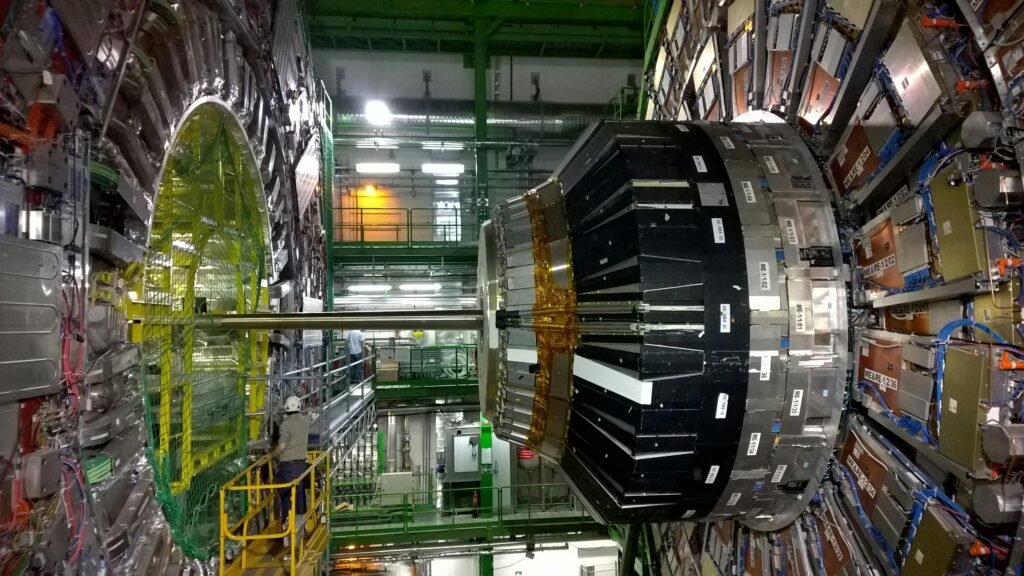Table of Contents
In July 2012, the scientific world was abuzz with the discovery of something that had long eluded scientists: the Higgs boson, commonly known as the “God Particle.” This name might sound grand, but what exactly is it, and why does it matter? Let’s explore this fascinating topic in simple terms.
What is the Higgs Boson?
The Higgs boson is a fundamental particle, part of a family of tiny particles that make up everything in the universe. These particles are the building blocks of atoms, and atoms make up all the matter we see around us — from stars and planets to the air we breathe and the food we eat.
But why is it so important? To understand this, let’s take a step back and look at how the universe works.
How the Universe Works
Imagine the universe as a giant puzzle. The pieces of the puzzle are made up of particles like protons, electrons, and neutrons. Scientists have spent decades trying to understand how these particles interact and how they fit together to form the universe as we know it.
Physicists developed something called the ‘Standard Model’ to explain how these particles work. The Standard Model is like a rulebook for understanding the forces and particles that make up the universe. It describes three of the four fundamental forces of nature (electromagnetism, the strong nuclear force, and the weak nuclear force) and the particles associated with these forces.
However, one important piece of the puzzle was missing. According to the Standard Model, particles should have no mass, yet we know that everything around us, including ourselves, has mass. So, what gives particles their mass? This is where the Higgs boson comes into the story.
Enter the Higgs Field
The idea of the Higgs boson is tied to something called the Higgs field. Think of the Higgs field as an invisible energy field that exists throughout the universe, similar to how the air is all around us, even though we can’t see it. As particles move through this field, they interact with it, and this interaction gives them mass.
To visualise this, imagine moving through water. If you try to walk through a swimming pool, the water resists your movement and slows you down. In the same way, particles moving through the Higgs field experience resistance, and this resistance gives them mass.
The Higgs boson is the particle which is the core of the Higgs field. In a way, it’s a sign that the Higgs field exists. Discovering the Higgs boson was like finding the missing piece of a puzzle — it confirmed that the Higgs field is real and explained how particles get their mass.
Why is it Called the “God Particle”?
The nickname “God Particle” can be a bit misleading. It doesn’t mean that the particle has anything to do with God or religion. The term actually comes from the title of a book written by physicist Leon Lederman in 1993. Lederman wanted to call it the “Goddamn Particle” because it was so hard to find, but his publisher shortened it to the “God Particle.” It does not have anything to do with god. The name stuck, even though many scientists don’t like it because it can create confusion.
How Was the Higgs Boson Discovered?
Finding the Higgs boson was no small task. It took decades of work and some of the most advanced technology in the world. The discovery happened at the Large Hadron Collider (LHC), a massive particle accelerator located underground near Geneva, Switzerland. The LHC is the world’s largest and most powerful machine of its kind, designed to smash particles together at incredibly high speeds.

When particles collide at the LHC, they break apart, and scientists can study the pieces to learn more about the universe. After many experiments, in 2012, scientists finally found evidence of the mysterious particle, confirming the existence of the Higgs field and helping to explain how particles get their mass.
Why is the Discovery Important?
The discovery of the Higgs boson was a monumental achievement in science. It completed the Standard Model and gave us a deeper understanding of the universe. But there are still many mysteries to solve. For example, the Standard Model doesn’t explain gravity, and scientists are still working to understand dark matter and dark energy, which make up most of the universe.
In many ways, the discovery of this particle is just the beginning. It opens up new questions and new possibilities for understanding the fundamental nature of reality.
The discovery of the Higgs boson, or the “God Particle,” was a groundbreaking moment in our quest to understand the universe. It confirmed the existence of the Higgs field and explained how particles get their mass. While this discovery has answered some big questions, it also raises new ones, pushing the boundaries of human knowledge and sparking curiosity about the unseen forces that shape our world.
Click here to learn more about the God particle.
What are your thoughts on the God particle? Let us know in the comments below.
You might also like: Dark matter and dark energy
